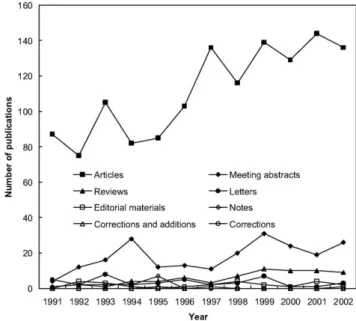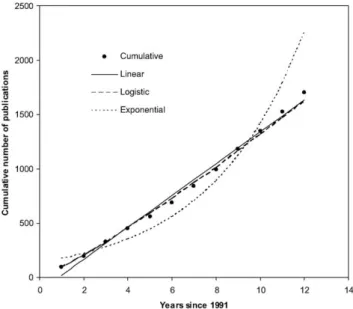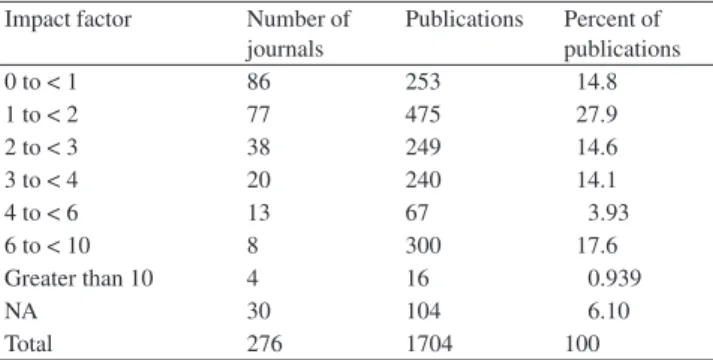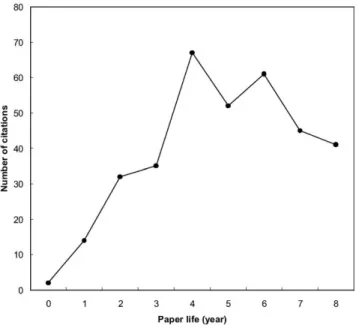Original article
Asthma in children: mapping the literature by bibliometric analysis
Su-Ru Chen
a, Wen-Ta Chiu
b, Y.S. Ho
c,a,*
aDepartment of Nursing, Taipei Medical University, School of Public Health, 250 Wu-Hsing Street, Taipei 11014, Taiwan, ROC bDepartment of Neurosurgery, Taipei Medical University, Wan-Fang Hospital, 111 Hsing-Long Road, Sec. 3, Taipei 116, Taiwan, ROC
cBibliometric Center, Taipei Medical University, Wan-Fang Hospital, 111 Hsing-Long Road, Sec. 3, Taipei 116, Taiwan, ROC Received 26 January 2005; accepted 4 August 2005
Available online 13 September 2005
Abstract
Aim. – To evaluate the publication output associated with research on asthma in children.
Methods. – The data encompassed the period from 1991 to 2002 and were extracted from the Science Citation Index online version.
Selected documents included ‘asthmatic children’ and ‘asthma children’ as a part of its title, abstract, or keyword from. Parameters analyzed included language, type of document, page count, publication output, country of publication, authorship, publication pattern, and the most frequently cited paper.
Results. – The yearly publications have increased from 1991 to 2002. The seven industrialized countries have high productivity in this
research field. English was the dominant language, and four or five authors were the moot common number of co-author. The US was the world leader and dominated most of the publications, followed by the UK.
Conclusions. – The most important functions of scientific publications are to communicate and exchange research findings and results.
The results of the study not only offer a comprehensive picture of asthma in children by bibliometric research, but also demonstrate the performance of research workers, institutions, and even countries.
© 2005 Elsevier SAS. All rights reserved.
Keywords: Asthmatic; Children; SCI; Scientometrics
1. Introduction
Asthma is a serious and complex disease involving bron-cho constriction, airway inflammation, hyper-responsiveness, and remodeling, all of which can lead to pulmonary dysfunc-tion and even death[1]. The onset of asthma symptoms at less than 5 years of age occurs 80% of the time[2]. Children aged 0–4 years have the largest increase in prevalence and greater health care use [3]. Asthma resulted in more than US$5.3 billion in indirect costs, $1.1 billion in lost school days, $1.5 billion in lost workdays, $840 million in caregiver/housekeeping costs, and $1.8 billion in mortality costs in the US in 1998[4]. Both of industrialized and devel-oping countries have spent lots of money and worked hard on studying asthma to lower the financial costs incurred by the entire society.
Bibliometric studies carried out in recent years have pro-vided an accurate and presumably objective method of
mea-suring the contribution of a paper to the advancement of knowledge. Recently, numerous research on medical topics has been analyzed using the bibliometric method, such as the severe acute respiratory syndrome (SARS)[5], patent ductus arteriosus[6], geography of clinical cancer research publica-tions[7], orthodontics[8], ophthalmology[9], cancer, cardio-vascular, and malaria research[10], AIDS[11], neuropedia-try and other pediatric subspecialities[12], rheumatology[13], homeopathy[14]. It is necessary to evaluate the performance of each topic in order to indicate the impact and contribution of each paper to its respective fields.
The most important functions of scientific publications are to communicate and exchange research findings and results. One method of assessing the productivity of scientific researchers is to evaluate their output. To a certain extent, the number of research papers reflects the activity and academic level of a scientist. Also, the annual number of research papers of an institute is often used as a quantitative indicator for evaluating the level of its basic research. Using the bibliomet-ric technique, we are able to evaluate for both researchers
* Corresponding author.
E-mail address: ysho@tmu.edu.tw (Y.S. Ho).
http://france.elsevier.com/direct/REVCLI/
0335-7457/$ - see front matter © 2005 Elsevier SAS. All rights reserved. doi:10.1016/j.allerg.2005.08.002
and institutions. The results of the study not only offer a com-prehensive picture of asthma in children by bibliometric research, but also demonstrate the performance of research workers, institutions, and even countries. In the following analysis, we attempt to provide an exhaustive inventory of all papers concerning asthma in children published during 1991– 2002.
2. Methods
The data were based on the database of the Science
Cita-tion Index (SCI) published by the subscribed from Institute
for Scientific Information (ISI) Web of Science, Philadel-phia, PA, USA. The analysis of publication papers was extracted upon a literature search using the online version of
SCI. ‘Asthmatic children’ and ‘asthma children’ were used as
keywords to search parts of titles, abstracts, or keywords. Articles, meeting abstracts, reviews, letters, editorial materi-als, notes, corrections and additions, and corrections were obtained from the search results for document types. Articles originating from England, Scotland, Northern Ireland, and Wales were grouped under the UK heading. The impact fac-tor (IF) of a journal was determined for each document as reported in the year 2002 Institute for Scientific Information (ISI), Journal Citation Reports (JCR). Collaboration type was determined by the address of each entry, where ‘indepen-dent’ was assigned if no collaboration was presented. ‘Inter-national collaboration’ was assigned if it was cosigned with researchers from other countries abroad.
Once retrieved, records were analyzed by the year of pub-lication, total number of authors, institutions and country, type of publications, language, page count, impact factor of a jour-nal in which the papers were published, and their total cita-tions also included from 1991 to 2002. This effort will pro-vide a current view of the mainstream research on asthmatic children all over the world, as well as clues to the impacts of the topic.
3. Results and discussion
The documents were analyzed according to their lan-guage, type of document, page count, publication output, country of publication, authorship, publication patterns, and the most frequently cited paper.
3.1. Language of publication
Language analysis showed that 1617 papers (94.9%) were published in English with French (61; 3.58%), German (17; 1.00%), Italian (5; 0.29%), Spanish (3; 0.18%), and Russian (1; 0.06%) accounting for the remaining share.
3.2. Type of document
The distribution of the document type identified by ISI was analyzed. From this analysis, eight document types were
found. In the period from 1991 to 2002, the distribution of document types was developed (Fig. 1). Articles, meeting abstracts, and reviews rose significantly. Other types still remained in low. Evaluating the distribution of types shows that out of the 1704 research documents on asthma in chil-dren, 1337 (78.5%) were original articles, distantly followed by meeting abstracts (216; 12.7%), reviews (68; 3.99%), let-ters (42; 2.46%), editorial materials (24; 1.41%), notes (14; 0.82%), corrections and additions (2; 0.12%), and correc-tions (1; 0.06%).
3.3. Page count
There were 9590 pages in the total 1704 papers. Among these papers, 238 or 13.8% consisted of only one page includ-ing 207 meetinclud-ing abstracts. Four- to seven-page papers com-prised 54.2%. However, six-page papers (272; 16.0%) were dominant. This was followed by five (251; 14.7%), one (236; 13.8%), and seven pages (211; 12.4%). At the other end of the scale, there were 32 or 1.3% of all papers had more than 15 pages including 20 review papers.
3.4. Publication output
The production trend has steadily increased in the past decade (Fig. 2). More than 50% of the records were pub-lished during the period 1998–2002. The total paper produc-tion showed two obvious peaks in 1993 and 1999. An increas-ing trend of the top 10 countries producincreas-ing publications also showed the same peaks in the same years. The contribution of the publication peak was affected by Italy, France, the Neth-erlands, Germany, and Canada in 1993 as well as by UK, France, Japan, and Sweden in 1999. The overall article pro-duction showed a growth pattern, in which the number papers per year increased by about two times in the following decade
Fig. 1.Pattern of the distribution of document types in the period from 1991 to 2002.
since 1991. A similar increasing trend in the number of coun-tries is also apparent inFig. 2. In addition, a significant cor-relation between yearly cumulative number of publications and the year was also made (Fig. 3). For the period from 1991 to 2002, the cumulative number of publications on rela-tive research on asthma in children has increased. Ninety-eight papers were published in 1991, while in 2002 the cumu-lative number of publications was 1704. The relationship between yearly cumulative number of publications and year was analyzed by using linear, logistic, and exponential equa-tions. Linear and logistic equations had high coefficient of determinations of 0.992 and 0.998 respectively. Linear fit-ting suggested that yearly publications were constantly sus-tained in each year. The logistic curve fitting, however, showed that yearly publications had a constant growth rate. It can be concluded that the number of publications on research on the topic of asthma in children is still growing by a small rate.
3.5. Country of publication
Table 1shows that asthma in children is an international research issue. There were 64 papers without author address information on the ISI Web of Science. For this reason, not all of the 1704 papers were included in the analyses of this section. Of 1640 papers, there was great diversity including 59 different countries, with the US producing the most papers (22.7%). Of the 1640 papers, 1463 (89.2%) were indepen-dent publications and 177 (10.8%) were international collabo-rative publications. Developed countries, such as the Nether-lands, Denmark, Sweden, and the seven major industrial countries (G7: Canada, France, Germany, Italy, Japan, the UK, and the US), were ranked in the top 10 of publications. Among these countries, the G7 published 69.7% of the 1640 papers. Moreover, G7 had high productivity in this topic, which included 861 (52.5% of 1640 papers) independent publica-tions. The UK (71) and US (70) produced the most interna-tional collaborative papers followed by Sweden (28), Ger-many (26), and Australia (19). Costa Rica, Bulgaria, Kenya, and the United Arab Emirates only had publications done through international collaboration. Ecuador, Indonesia, Leba-non, Libya, Mauritius, Morocco, Nigeria, Pakistan, Peru, Slo-venia, Qatar, Tunisia, Venezuela, Malaysia, Kuwait, Egypt, Saudi Arabia, and Turkey had no internationally collabora-tive publications. In addition, the top 10 countries ranked by number of publications inTable 1were compared by the mean IF per paper. The UK ranked first with a mean IF of 3.598 fol-lowed by the Netherlands (3.533), the US (3.460), Sweden (3.242), Denmark (3.224), Italy (3.157), Canada (2.984), Japan (2.906), Germany (2.296), and France (1.587). One hundred four papers from 33 countries considered were pub-lished in journals with no IF. The world IF for asthma in chil-dren papers was 3.025. The mean IF has also been analyzed for the geography of clinical cancer research publications. Canada ranked first with a mean IF of 3.95[5].
3.6. Authorship
The most frequent number of authors was five with 230 (13.5%) papers; 1455 (85.4%) papers were published by one
Fig. 2.Annual publication output.
Fig. 3.Relationship between cumulative number of publications and year.
Table 1
Top 10 countries of authors (first authors and co-authors) of documents with their impact factor (estimated in 2002)
Country IP CP TP %TP TIF MIF WIF %WIF
USA 302 70 372 22.7 1162.636 3.460 36 9.68 UK 148 71 219 13.4 777.24 3.598 3 1.37 Italy 110 16 126 7.7 385.19 3.157 4 3.17 France 99 10 109 6.65 160.305 1.587 8 7.34 Japan 93 3 96 5.85 249.92 2.906 10 10.4 Netherlands 77 13 90 5.49 307.334 3.533 3 3.33 Germany 62 26 88 5.37 185.976 2.296 7 7.95 Denmark 69 16 85 5.18 264.382 3.224 3 3.53 Sweden 33 28 61 3.72 197.783 3.242 0 0 Canada 47 12 59 3.60 158.149 2.984 6 10.2 IP, independent publication; CP, international collaborative publication; TP, total publication; TIF, total impact factor; MIF, mean impact factor; WIF, papers without an impact factor.
to six authors. Further analysis was carried out on the corre-sponding author of the papers. There were 62 cases for which the corresponding author address information was missing in the ISI. The G7 had high productivity in this research with the corresponding author including 952 (55.9%) publica-tions. The most productive country was the US (325, 19.1%), while 65.1% of 1642 papers were published by the top 10 pro-ductive countries, including the G7, the Netherlands, Den-mark, and Finland.
3.7. Publication pattern
In total, 1704 papers were published in a wide range of 276 journals distributed across 28 countries during the time span from 1991 to 2002. Thirty journals had no impact factor in the ISI. The top five journal countries were the US, which published 96 (34.8%) journals, the UK with 55 (19.9%), Ger-many with 16 (5.80%), and Switzerland and the Netherlands with 11 each (3.99%). The US and the UK published 54.7% of the Journals including 1205 (70.7%) publications.
Table 2lists the 20 journals with the greatest number of published papers on asthma in children, their journal coun-try, number of publication, and corresponding percentage and impact factor indexed in the 2002 edition of the Journal
Cita-tion Reports (JCR) published by the ISI. The Journal of Allergy and Clinical Immunology, which is published in the
US was first and published 196 (11.5%) of all papers. Second on the list is Pediatric Pulmonology, which is also published in the US and it was responsible for 108 (6.34%) of all papers. The third is the European Respiratory Journal. It is pro-duced in the UK and published 104 (6.10%) of all papers. With regard to these journals covering the scope of asthma in children, four journals had an impact factor of > 10. Sixteen
papers were published by them. Most of the journals had impact factors, which ranged from 0 to 3, accounting for 72.8% of all papers studied (Table 3). Journals with IFs of 1–2 published 475 (27.9%) papers, 300 (17.6%) were pub-lished by journals with IFs 6–10.
3.8. Most frequently cited paper
The time dependence on a single article is called its his-tory and may be viewed as the ‘sales figure’ of the article
[15]. Among articles on asthma in children, the most fre-quently cited was ‘Effects of long-term treatment with an inhaled corticosteroid on growth and pulmonary-function in asthmatic-children’[16]. This article, in 1994 by Agertoft and Pedersen, was published in Respiratory Medicine and was cited 347 times to 2002 since its publication. The citation history of this most frequently cited article is shown inFig. 4. The citations slightly increased after it was published and reached a maximum after 4 years. However, a decrease appeared 5 years later.
Table 2
The 20 journals with the highest number of publication, including impact factor (estimated in 2002), journal country, number of publications, and correspon-ding percentage
Journal IF JC P P%
Journal of Allergy and Clinical Immunology 6.282 USA 196 11.50
Pediatric Pulmonology 1.739 USA 108 6.34
European Respiratory Journal 2.931 UK 104 6.10
Clinical and Experimental Allergy 3.721 UK 80 4.69
American Journal of Respiratory and Critical Care Medicine 6.567 USA 80 4.69
Journal of Child and Adolescent Psychopharmacology 1.02 USA 79 4.64
Allergy 3.666 Denmark 63 3.70
Annals of Allergy Asthma and Immunology 1.67 USA 52 3.05
Thorax 4.078 UK 48 2.82
Pediatric Allergy and Immunology 1.807 Denmark 39 2.29
Chest 2.969 USA 39 2.29
Respiratory Medicine 1.496 UK 33 1.94
Archives of Disease in Childhood 2.095 UK 33 1.94
Revue Francaise d Allergologie et d Immunologie Clinique 0.302 France 32 1.88
Annals of Allergy NA NA 27 1.58
Pediatric Research 3.382 USA 26 1.53
Acta Pediatrica 1.26 Norway 25 1.47
Pediatric Asthma Allergy and Immunology NA NA 22 1.29
Journal of Investigational Allergology and Clinical Immunology 0.604 Germany 21 1.23
Pediatrics 3.416 USA 21 1.23
NA, no record in the JCR, JC, journal country; P, publication.
Table 3
Impact factor (estimated in 2002) in terms of productivity Impact factor Number of
journals Publications Percent of publications 0 to < 1 86 253 14.8 1 to < 2 77 475 27.9 2 to < 3 38 249 14.6 3 to < 4 20 240 14.1 4 to < 6 13 67 3.93 6 to < 10 8 300 17.6 Greater than 10 4 16 0.939 NA 30 104 6.10 Total 276 1704 100
4. Conclusions
There were several findings of the study. Publications on asthma in children in the world indexed in the SCI increased over the decade from the period of 1991–2002. On this topic, the US was the world leader and dominated most of the pub-lications, followed by the UK. The seven industrialized coun-tries held the majority of the total production. English was the dominant language, and four or five authors were the moot common number of co-author.
References
[1] Sears MR. Epidemiology of childhood asthma. Lancet 1997;350: 1015–20.
[2] Skoner DP. Management and treatment of pediatric asthma: update. Allergy Asthma Proc 2001;22:71–4.
[3] Akinbami LJ, Schoendorf KC. Trends in childhood asthma: preva-lence, health care utilization, and mortality. Pediatrics 2002;110:315– 22.
[4] Weiss KB, Sullivan SD. The health economics of asthma and rhinitis. I. Assessing the economic impact. J Allergy Clin Immun 2001;107: 3–8.
[5] Chiu WT, Huang JS, Ho YS. Bibliometric analysis of severe acute respiratory syndrome-related research in the beginning stage. Scien-tometrics 2004;61:69–77.
[6] Hsieh WH, Chiu WT, Lee YS, Ho YS. Bibliometric analysis of patent ductus arteriosus treatments. Scientometrics 2004;60:205–15. [7] Grossi F, Belvedere O, Rosso R. Geography of clinical cancer
research publications from 1995 to 1999. Eur J Cancer 2003;39:106– 11.
[8] Mavropoulos A, Kiliaridis S. Orthodontic literature: an overview of the last two decades. Am J Orthod Dentofac 2003;124:30–40. [9] Mojon-Azzil SM, Jiang XY, Wagner U, St Mojon D. Ophthalmology
‘Made in Switzerland’ - Swiss papers listed in MEDLINE. Klin Monatsbl Augenh 2002;219:866–71.
[10] Rodrigues PS, Fonseca L, Chaimovich H. Mapping cancer, cardiovas-cular and malaria research in Brazil. Braz J Med Biol Res 2000;33: 853–67.
[11] Macias-Chapula CA, Sotolongo-Aguilar GR, Magde B, Solorio-Lagunas J. Subject content analysis of AIDS literature, as produced in Latin America and the Caribbean. Scientometrics 1999;46:563–74. [12] de Dios JG, Moya M. The neuropediatry and the other pediatric
subspecialities: analysis by means of bibliometry. Rev Neurol 1999; 28:463–71.
[13] Batlle-Gualda E, Larraz PT, Pons RN, Laserna CG. Investigation in Rheumatology. Analysis of Spanish documents published during 1990–1996 in nine foreign specialty journals. Rev Clin Esp 1998;198: 587–95.
[14] Chiu WT, Ho YS. Bibliometric analysis of homeopathy research during the period of 1991 to 2003. Scientometrics 2005;63:3–23. [15] Marx W, Cardona M. The impact of Solid State Communications in
view of the ISI Citation data. Solid State Commun 2003;127:323–36. [16] Agertoft L, Pedersen S. Effects of long-term treatment with an inhaled corticosteroid on growth and pulmonary-function in asthmatic-children. Resp Med 1994;88:373–81.



